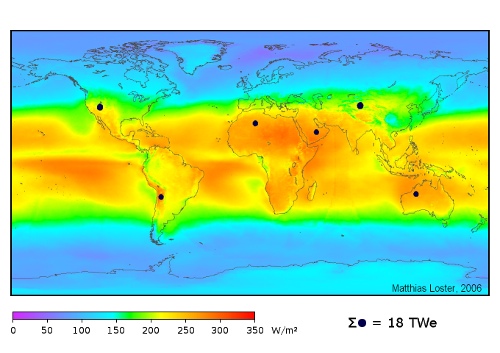The sun – inexhaustible energy source

Figure 2: Global solar radiation and potential for electricity generation (Source: Loster 2006, http://en.wikipedia.org/wiki/File:Solar_land_area.png)
This world map shows the average local solar radiation on the earth’s surface, including radiation at night and under cloud cover.
Note the small dark discs: If only the solar radiation in these areas were used, the whole Earth could already be supplied with electricity.
Source: Loster, 2010
At present only a small part of the world’s energy demand is covered by solar energy. However, as fossil fuels such as oil become more and more expensive, it is inevitable that renewable energy sources will be used more and more. Photovoltaics has the greatest global potential here, as solar radiation is available in unlimited quantities and the raw materials for the solar cells (usually silicon) are also very readily available.
In Bavaria, 5 % of the annual energy demand is already covered by photovoltaics, and in summer this figure rises to around 40 %. This example shows that a greater use of solar energy is possible through appropriate subsidies and political framework conditions.
Solar energy in numbers: Energy radiation of the solar surface about 75.000 kW/m² Irradiance on the earth's surface averages about 1 kW/m², from 50 W/m² with a very cloudy sky to about 1,200 W/m² with optimal cloud cover Irradiated energy quantity per year in Austria: 1,000 to 1,400 kWh/m²a Maximum solar radiation: 2,200 kWh/m²a (areas in Australia, South and Central Africa, America) The solar radiation corresponds to about 10,000 times the current primary energy consumption of mankind. (Source: http://kurse.ibo.at/mod/scorm/player.php?a=20¤torg=eXesanieren_24823c6301d864942c32&scoid=466)


 Disclaimer: Powered by Erasmus+, ACTeco, ASBN and d.sign Gruber & Partner
Disclaimer: Powered by Erasmus+, ACTeco, ASBN and d.sign Gruber & Partner
You must be logged in to post a comment.